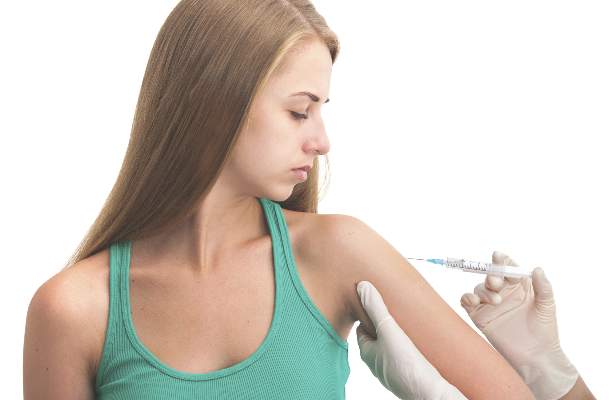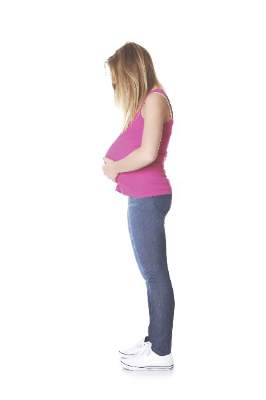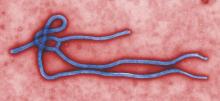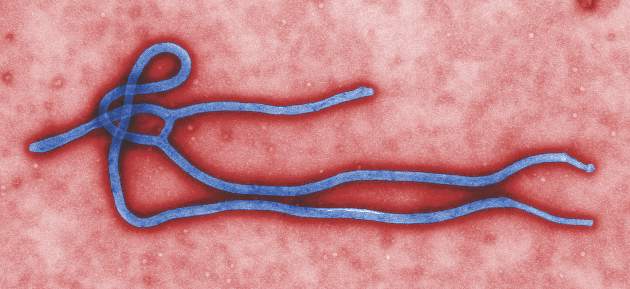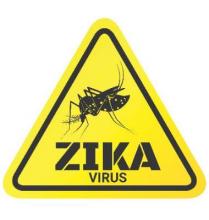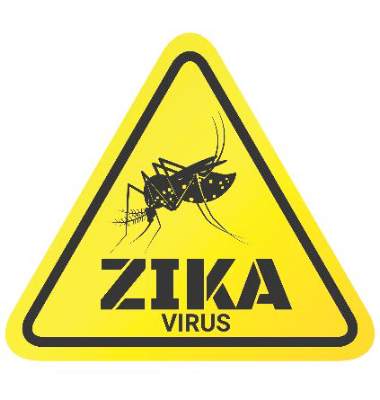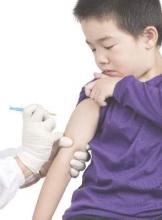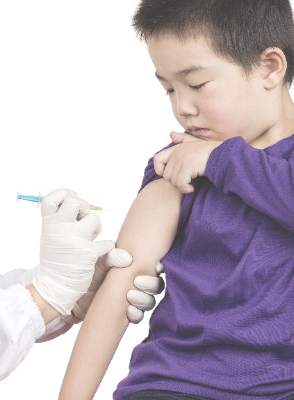User login
DTaP/IPV plus bivalent rLP2086 vaccine deemed noninferior in adolescents
Concomitant administration of the meningococcal serogroup B vaccine bivalent rLP2086 with the diphtheria, tetanus, and acellular pertussis and inactivated poliovirus (DTaP/IPV) vaccine produced a immunologically noninferior response in adolescents, compared with administration of DTaP/IPV alone.
Timo Vesikari, MD, PhD, of the University of Tampere (Finland) Medical School and his associates randomized healthy adolescents aged 11-18 years to receive either bivalent rLP2086 plus DTaP/IPV (373 patients) or DTaP/IPV plus saline (376 patients). The researchers achieved the primary objective of the study – demonstrating the noninferiority of rLP2086 with DTaP/IPV. The lower bound of the two-sided 95% confidence interval for the difference in the proportion of responders between the two groups 1 month after the DTaP/IPV dose was greater than –10% for the nine DTaP/IPV antigens. Levels of antibodies to the DTaP/IPV antigens, measured as geometric means, also were similar between the vaccine groups for each antigen, according to the researchers.
There also were substantial immune responses to bivalent rLP2086 plus DTaP/IPV, as measured with serum bactericidal assays using human complement (hSBAs) 1 month after the second vaccination, which increased even more after the third vaccination. The proportions of bivalent rLP2086-plus-DTaP/IPV recipients with prespecified seroprotective hSBA titers to the four meningococcal serogroup B test strains were between 55.5% and 97.3% after vaccination two and between 81.5% and 100% after vaccination three.
“Bivalent rLP2086 was well tolerated and elicited substantial and broad bactericidal responses to diverse [meningococcal serogroup B] strains in a high proportion of recipients after 2 vaccinations, and these responses were further enhanced after 3 vaccinations,” the researchers wrote.
Read the full study in the Journal of the Pediatric Infectious Diseases Society (2016 Jun;5[2]:180-7. doi: 10.1093/jpids/piv064).
Concomitant administration of the meningococcal serogroup B vaccine bivalent rLP2086 with the diphtheria, tetanus, and acellular pertussis and inactivated poliovirus (DTaP/IPV) vaccine produced a immunologically noninferior response in adolescents, compared with administration of DTaP/IPV alone.
Timo Vesikari, MD, PhD, of the University of Tampere (Finland) Medical School and his associates randomized healthy adolescents aged 11-18 years to receive either bivalent rLP2086 plus DTaP/IPV (373 patients) or DTaP/IPV plus saline (376 patients). The researchers achieved the primary objective of the study – demonstrating the noninferiority of rLP2086 with DTaP/IPV. The lower bound of the two-sided 95% confidence interval for the difference in the proportion of responders between the two groups 1 month after the DTaP/IPV dose was greater than –10% for the nine DTaP/IPV antigens. Levels of antibodies to the DTaP/IPV antigens, measured as geometric means, also were similar between the vaccine groups for each antigen, according to the researchers.
There also were substantial immune responses to bivalent rLP2086 plus DTaP/IPV, as measured with serum bactericidal assays using human complement (hSBAs) 1 month after the second vaccination, which increased even more after the third vaccination. The proportions of bivalent rLP2086-plus-DTaP/IPV recipients with prespecified seroprotective hSBA titers to the four meningococcal serogroup B test strains were between 55.5% and 97.3% after vaccination two and between 81.5% and 100% after vaccination three.
“Bivalent rLP2086 was well tolerated and elicited substantial and broad bactericidal responses to diverse [meningococcal serogroup B] strains in a high proportion of recipients after 2 vaccinations, and these responses were further enhanced after 3 vaccinations,” the researchers wrote.
Read the full study in the Journal of the Pediatric Infectious Diseases Society (2016 Jun;5[2]:180-7. doi: 10.1093/jpids/piv064).
Concomitant administration of the meningococcal serogroup B vaccine bivalent rLP2086 with the diphtheria, tetanus, and acellular pertussis and inactivated poliovirus (DTaP/IPV) vaccine produced a immunologically noninferior response in adolescents, compared with administration of DTaP/IPV alone.
Timo Vesikari, MD, PhD, of the University of Tampere (Finland) Medical School and his associates randomized healthy adolescents aged 11-18 years to receive either bivalent rLP2086 plus DTaP/IPV (373 patients) or DTaP/IPV plus saline (376 patients). The researchers achieved the primary objective of the study – demonstrating the noninferiority of rLP2086 with DTaP/IPV. The lower bound of the two-sided 95% confidence interval for the difference in the proportion of responders between the two groups 1 month after the DTaP/IPV dose was greater than –10% for the nine DTaP/IPV antigens. Levels of antibodies to the DTaP/IPV antigens, measured as geometric means, also were similar between the vaccine groups for each antigen, according to the researchers.
There also were substantial immune responses to bivalent rLP2086 plus DTaP/IPV, as measured with serum bactericidal assays using human complement (hSBAs) 1 month after the second vaccination, which increased even more after the third vaccination. The proportions of bivalent rLP2086-plus-DTaP/IPV recipients with prespecified seroprotective hSBA titers to the four meningococcal serogroup B test strains were between 55.5% and 97.3% after vaccination two and between 81.5% and 100% after vaccination three.
“Bivalent rLP2086 was well tolerated and elicited substantial and broad bactericidal responses to diverse [meningococcal serogroup B] strains in a high proportion of recipients after 2 vaccinations, and these responses were further enhanced after 3 vaccinations,” the researchers wrote.
Read the full study in the Journal of the Pediatric Infectious Diseases Society (2016 Jun;5[2]:180-7. doi: 10.1093/jpids/piv064).
FROM THE JOURNAL OF THE PEDIATRIC INFECTIOUS DISEASES SOCIETY
Indiana HIV outbreak linked to injection use of oxymorphone
The 2014-2015 HIV infection outbreak in Indiana was associated with the injection-drug use of extended-release oxymorphone, according to a study published in the New England Journal of Medicine.
The study examined 181 HIV-1 infections diagnosed in patients in Scott County, Ind., from Nov. 18, 2014, to Nov. 1, 2015. Of these outbreak-related cases, a total of 159 patients (87.8%) reported injecting the extended-release formulation of the prescription opioid oxymorphone in the previous 12 months. In addition, 173 of the 181 patients reported other injection-drug use, including 47 (27.2%) who reported occasionally injecting heroin, 40 (23.1%) who reported injecting methamphetamine, 15 (8.7%) who reported injecting cocaine, and 2 (1.2%) who reported injecting oxycodone.
Researchers noted that the first three HIV cases in the patient network were detected during routine HIV screening, while eight more cases were diagnosed in syringe-sharing partners of these case patients. All 11 of these HIV-infected persons reported having injected oxymorphone, and a subsequent public health investigation that included contact tracing and phylogenetic analyses of HIV and hepatitis C virus (HCV) sequences revealed the extent of the outbreak. Ultimately, 167 case patients (92.3%) were coinfected with HCV before and during the outbreak.
“Although the proactive deployment of interventions for HIV prevention among persons who inject drugs is challenging in rural areas that have a low incidence of HIV but are at risk for an outbreak, the implementation of HIV testing and treatment, syringe-service programs, and medication-assisted treatment are necessary to help prevent a similar outbreak in the future,” the researchers concluded.
Read the full study here (doi:10.1056/NEJMoa1515195).
The 2014-2015 HIV infection outbreak in Indiana was associated with the injection-drug use of extended-release oxymorphone, according to a study published in the New England Journal of Medicine.
The study examined 181 HIV-1 infections diagnosed in patients in Scott County, Ind., from Nov. 18, 2014, to Nov. 1, 2015. Of these outbreak-related cases, a total of 159 patients (87.8%) reported injecting the extended-release formulation of the prescription opioid oxymorphone in the previous 12 months. In addition, 173 of the 181 patients reported other injection-drug use, including 47 (27.2%) who reported occasionally injecting heroin, 40 (23.1%) who reported injecting methamphetamine, 15 (8.7%) who reported injecting cocaine, and 2 (1.2%) who reported injecting oxycodone.
Researchers noted that the first three HIV cases in the patient network were detected during routine HIV screening, while eight more cases were diagnosed in syringe-sharing partners of these case patients. All 11 of these HIV-infected persons reported having injected oxymorphone, and a subsequent public health investigation that included contact tracing and phylogenetic analyses of HIV and hepatitis C virus (HCV) sequences revealed the extent of the outbreak. Ultimately, 167 case patients (92.3%) were coinfected with HCV before and during the outbreak.
“Although the proactive deployment of interventions for HIV prevention among persons who inject drugs is challenging in rural areas that have a low incidence of HIV but are at risk for an outbreak, the implementation of HIV testing and treatment, syringe-service programs, and medication-assisted treatment are necessary to help prevent a similar outbreak in the future,” the researchers concluded.
Read the full study here (doi:10.1056/NEJMoa1515195).
The 2014-2015 HIV infection outbreak in Indiana was associated with the injection-drug use of extended-release oxymorphone, according to a study published in the New England Journal of Medicine.
The study examined 181 HIV-1 infections diagnosed in patients in Scott County, Ind., from Nov. 18, 2014, to Nov. 1, 2015. Of these outbreak-related cases, a total of 159 patients (87.8%) reported injecting the extended-release formulation of the prescription opioid oxymorphone in the previous 12 months. In addition, 173 of the 181 patients reported other injection-drug use, including 47 (27.2%) who reported occasionally injecting heroin, 40 (23.1%) who reported injecting methamphetamine, 15 (8.7%) who reported injecting cocaine, and 2 (1.2%) who reported injecting oxycodone.
Researchers noted that the first three HIV cases in the patient network were detected during routine HIV screening, while eight more cases were diagnosed in syringe-sharing partners of these case patients. All 11 of these HIV-infected persons reported having injected oxymorphone, and a subsequent public health investigation that included contact tracing and phylogenetic analyses of HIV and hepatitis C virus (HCV) sequences revealed the extent of the outbreak. Ultimately, 167 case patients (92.3%) were coinfected with HCV before and during the outbreak.
“Although the proactive deployment of interventions for HIV prevention among persons who inject drugs is challenging in rural areas that have a low incidence of HIV but are at risk for an outbreak, the implementation of HIV testing and treatment, syringe-service programs, and medication-assisted treatment are necessary to help prevent a similar outbreak in the future,” the researchers concluded.
Read the full study here (doi:10.1056/NEJMoa1515195).
FROM THE NEW ENGLAND JOURNAL OF MEDICINE
Teen birth rate continues to decline
The U.S teen birth rate has dropped for another consecutive year, adding to the long-term decline in teen pregnancy, according to a federal report on trends in child health and well being.
In 2014, the teen birth rate was 11 births per 1,000 girls’ aged 15-17 years, down from 12 per 1,000 in 2013. Racial and ethinic disparities in the teen birth rate have also dropped significantly since 1995 – with the difference between the highest and lowest rates dropping from 55 points in 1995 to 17 points in 2014. But substantial disparities persist.
The report also found that the percentages of 10th and 12th-graders in all racial and ethnic groups who binge-drink were the lowest in 2015 since the report started in 1980. The percentage of uninsured children also declined, falling from 7% in 2013 to 5% in 2014. However, there was no improvement in the rate of childhood obesity. During 2011-2014, 19% of children aged 6-17 years were obese.
The annual report is published by the Federal Interagency Forum on Child and Family Statistics, a working group of 23 federal agencies that collect, analyze and report data on conditions and trends related to child and family well-being. The report tracks 41 health and social indicators.
Read the full 2016 America’s Children Report here.
The U.S teen birth rate has dropped for another consecutive year, adding to the long-term decline in teen pregnancy, according to a federal report on trends in child health and well being.
In 2014, the teen birth rate was 11 births per 1,000 girls’ aged 15-17 years, down from 12 per 1,000 in 2013. Racial and ethinic disparities in the teen birth rate have also dropped significantly since 1995 – with the difference between the highest and lowest rates dropping from 55 points in 1995 to 17 points in 2014. But substantial disparities persist.
The report also found that the percentages of 10th and 12th-graders in all racial and ethnic groups who binge-drink were the lowest in 2015 since the report started in 1980. The percentage of uninsured children also declined, falling from 7% in 2013 to 5% in 2014. However, there was no improvement in the rate of childhood obesity. During 2011-2014, 19% of children aged 6-17 years were obese.
The annual report is published by the Federal Interagency Forum on Child and Family Statistics, a working group of 23 federal agencies that collect, analyze and report data on conditions and trends related to child and family well-being. The report tracks 41 health and social indicators.
Read the full 2016 America’s Children Report here.
The U.S teen birth rate has dropped for another consecutive year, adding to the long-term decline in teen pregnancy, according to a federal report on trends in child health and well being.
In 2014, the teen birth rate was 11 births per 1,000 girls’ aged 15-17 years, down from 12 per 1,000 in 2013. Racial and ethinic disparities in the teen birth rate have also dropped significantly since 1995 – with the difference between the highest and lowest rates dropping from 55 points in 1995 to 17 points in 2014. But substantial disparities persist.
The report also found that the percentages of 10th and 12th-graders in all racial and ethnic groups who binge-drink were the lowest in 2015 since the report started in 1980. The percentage of uninsured children also declined, falling from 7% in 2013 to 5% in 2014. However, there was no improvement in the rate of childhood obesity. During 2011-2014, 19% of children aged 6-17 years were obese.
The annual report is published by the Federal Interagency Forum on Child and Family Statistics, a working group of 23 federal agencies that collect, analyze and report data on conditions and trends related to child and family well-being. The report tracks 41 health and social indicators.
Read the full 2016 America’s Children Report here.
New antibiotics targeting MDR pathogens are expensive, but not impressive
The U.S. Food and Drug Administration has approved a number of new antibiotics targeting multidrug-resistant bacteria in the past 5 years, but the new drugs have not led to a substantial improvement in patient outcomes when compared with existing antibiotics, according to a recent analysis in the Annals of Internal Medicine.
The eight new antibiotics approved by the FDA between January 2010 and December 2015 were ceftaroline, fidaxomicin, bedaquiline, dalbavancin, tedizolid, oritavancin, ceftolozane/tazobactam, and ceftazidime/avibactam. Of those eight drugs, only three showed in vitro activity against the so-called ESKAPE pathogens (Enterococcus faecium, Staphylococcus aureus, Klebsiella pneumonia, Acinetobacter baumannii, Pseudomonas aeruginosa, and Enterobacter species). Only one drug, fidaxomicin, demonstrated in vitro activity against an urgent-threat pathogen from the Centers for Disease Control and Prevention, Clostridium difficile. Bedaquiline was the only new antibiotic specifically indicated for a disease from a multidrug-resistant pathogen, although the investigators said most of the drugs demonstrated in vitro activity against gram-positive drug-resistant pathogens.
Importantly, the authors noted that in vitro activity does not necessarily reflect benefits on actual patient clinical outcomes, as exemplified by such drugs as tigecycline and doripenem.
The researchers found what they called “important deficiencies in the clinical trials leading to approval of these new antibiotic products.” Most pivotal trial designs were primarily noninferiority trials, and the antibiotics were not studied to evaluate whether they have substantial benefits in efficacy over what is currently available, they noted. Additionally, none of the trials evaluated direct patient outcomes as primary end points, and some drugs did not have confirmatory evidence from a second independent trial or did not have any confirmatory trials.
Researchers also examined the prices of a single dose of the new antibiotics. The prices ranged from $1,195 to $4,183 (4-14 days of ceftolozane/tazobactam for acute pyelonephritis and intra-abdominal infections) to $69,702 (24 weeks of bedaquiline) – quite a premium for antibiotics showing unclear evidence of additional benefit.
“As antibiotic innovation continues to move forward, greater attention needs to be paid to incentives for developing high-quality new products with demonstrated superiority to existing products on outcomes in patients with multidrug-resistant disease, replacing the current focus on quantity and presumed future benefits,” researchers concluded.
Read the full study in the Annals of Internal Medicine (doi: 10.7326/M16-0291).
The U.S. Food and Drug Administration has approved a number of new antibiotics targeting multidrug-resistant bacteria in the past 5 years, but the new drugs have not led to a substantial improvement in patient outcomes when compared with existing antibiotics, according to a recent analysis in the Annals of Internal Medicine.
The eight new antibiotics approved by the FDA between January 2010 and December 2015 were ceftaroline, fidaxomicin, bedaquiline, dalbavancin, tedizolid, oritavancin, ceftolozane/tazobactam, and ceftazidime/avibactam. Of those eight drugs, only three showed in vitro activity against the so-called ESKAPE pathogens (Enterococcus faecium, Staphylococcus aureus, Klebsiella pneumonia, Acinetobacter baumannii, Pseudomonas aeruginosa, and Enterobacter species). Only one drug, fidaxomicin, demonstrated in vitro activity against an urgent-threat pathogen from the Centers for Disease Control and Prevention, Clostridium difficile. Bedaquiline was the only new antibiotic specifically indicated for a disease from a multidrug-resistant pathogen, although the investigators said most of the drugs demonstrated in vitro activity against gram-positive drug-resistant pathogens.
Importantly, the authors noted that in vitro activity does not necessarily reflect benefits on actual patient clinical outcomes, as exemplified by such drugs as tigecycline and doripenem.
The researchers found what they called “important deficiencies in the clinical trials leading to approval of these new antibiotic products.” Most pivotal trial designs were primarily noninferiority trials, and the antibiotics were not studied to evaluate whether they have substantial benefits in efficacy over what is currently available, they noted. Additionally, none of the trials evaluated direct patient outcomes as primary end points, and some drugs did not have confirmatory evidence from a second independent trial or did not have any confirmatory trials.
Researchers also examined the prices of a single dose of the new antibiotics. The prices ranged from $1,195 to $4,183 (4-14 days of ceftolozane/tazobactam for acute pyelonephritis and intra-abdominal infections) to $69,702 (24 weeks of bedaquiline) – quite a premium for antibiotics showing unclear evidence of additional benefit.
“As antibiotic innovation continues to move forward, greater attention needs to be paid to incentives for developing high-quality new products with demonstrated superiority to existing products on outcomes in patients with multidrug-resistant disease, replacing the current focus on quantity and presumed future benefits,” researchers concluded.
Read the full study in the Annals of Internal Medicine (doi: 10.7326/M16-0291).
The U.S. Food and Drug Administration has approved a number of new antibiotics targeting multidrug-resistant bacteria in the past 5 years, but the new drugs have not led to a substantial improvement in patient outcomes when compared with existing antibiotics, according to a recent analysis in the Annals of Internal Medicine.
The eight new antibiotics approved by the FDA between January 2010 and December 2015 were ceftaroline, fidaxomicin, bedaquiline, dalbavancin, tedizolid, oritavancin, ceftolozane/tazobactam, and ceftazidime/avibactam. Of those eight drugs, only three showed in vitro activity against the so-called ESKAPE pathogens (Enterococcus faecium, Staphylococcus aureus, Klebsiella pneumonia, Acinetobacter baumannii, Pseudomonas aeruginosa, and Enterobacter species). Only one drug, fidaxomicin, demonstrated in vitro activity against an urgent-threat pathogen from the Centers for Disease Control and Prevention, Clostridium difficile. Bedaquiline was the only new antibiotic specifically indicated for a disease from a multidrug-resistant pathogen, although the investigators said most of the drugs demonstrated in vitro activity against gram-positive drug-resistant pathogens.
Importantly, the authors noted that in vitro activity does not necessarily reflect benefits on actual patient clinical outcomes, as exemplified by such drugs as tigecycline and doripenem.
The researchers found what they called “important deficiencies in the clinical trials leading to approval of these new antibiotic products.” Most pivotal trial designs were primarily noninferiority trials, and the antibiotics were not studied to evaluate whether they have substantial benefits in efficacy over what is currently available, they noted. Additionally, none of the trials evaluated direct patient outcomes as primary end points, and some drugs did not have confirmatory evidence from a second independent trial or did not have any confirmatory trials.
Researchers also examined the prices of a single dose of the new antibiotics. The prices ranged from $1,195 to $4,183 (4-14 days of ceftolozane/tazobactam for acute pyelonephritis and intra-abdominal infections) to $69,702 (24 weeks of bedaquiline) – quite a premium for antibiotics showing unclear evidence of additional benefit.
“As antibiotic innovation continues to move forward, greater attention needs to be paid to incentives for developing high-quality new products with demonstrated superiority to existing products on outcomes in patients with multidrug-resistant disease, replacing the current focus on quantity and presumed future benefits,” researchers concluded.
Read the full study in the Annals of Internal Medicine (doi: 10.7326/M16-0291).
FROM ANNALS OF INTERNAL MEDICINE
Biomarkers more specific in severe EVD than in moderate disease
Biomarkers associated with severe Ebola virus disease (EVD) were more specific than were those associated with moderate EVD, in a small study, according to Dr. Anita K. McElroy and her associates.
In the study of seven (two severe, five moderate) patients with EVD, 54 biomarkers in plasma samples were analyzed to define the kinetics of inflammatory modulators. Of these, 6 had a statistically significant association with moderate disease and 17 with severe disease. The patients with severe disease had higher viremia (P = .0003). Among 16 biomarkers correlated with viremia, 11 were associated with severe disease.
The researchers noted that the interleukin-6 differences between moderate and severe disease were not statistically significant because of the small numbers of samples in the moderate group that had detectable levels; however, there is a direct association between severity and interleukin-6 levels.
“The results from this study illuminate the beneficial vs. harmful host immune responses in EVD,” the researchers concluded. “The next step is to generate testable hypotheses about these physiologic processes and evaluate them using relevant animal models.”
Find the full study in Clinical Infectious Diseases (doi: 10.1093/cid/ciw334).
Biomarkers associated with severe Ebola virus disease (EVD) were more specific than were those associated with moderate EVD, in a small study, according to Dr. Anita K. McElroy and her associates.
In the study of seven (two severe, five moderate) patients with EVD, 54 biomarkers in plasma samples were analyzed to define the kinetics of inflammatory modulators. Of these, 6 had a statistically significant association with moderate disease and 17 with severe disease. The patients with severe disease had higher viremia (P = .0003). Among 16 biomarkers correlated with viremia, 11 were associated with severe disease.
The researchers noted that the interleukin-6 differences between moderate and severe disease were not statistically significant because of the small numbers of samples in the moderate group that had detectable levels; however, there is a direct association between severity and interleukin-6 levels.
“The results from this study illuminate the beneficial vs. harmful host immune responses in EVD,” the researchers concluded. “The next step is to generate testable hypotheses about these physiologic processes and evaluate them using relevant animal models.”
Find the full study in Clinical Infectious Diseases (doi: 10.1093/cid/ciw334).
Biomarkers associated with severe Ebola virus disease (EVD) were more specific than were those associated with moderate EVD, in a small study, according to Dr. Anita K. McElroy and her associates.
In the study of seven (two severe, five moderate) patients with EVD, 54 biomarkers in plasma samples were analyzed to define the kinetics of inflammatory modulators. Of these, 6 had a statistically significant association with moderate disease and 17 with severe disease. The patients with severe disease had higher viremia (P = .0003). Among 16 biomarkers correlated with viremia, 11 were associated with severe disease.
The researchers noted that the interleukin-6 differences between moderate and severe disease were not statistically significant because of the small numbers of samples in the moderate group that had detectable levels; however, there is a direct association between severity and interleukin-6 levels.
“The results from this study illuminate the beneficial vs. harmful host immune responses in EVD,” the researchers concluded. “The next step is to generate testable hypotheses about these physiologic processes and evaluate them using relevant animal models.”
Find the full study in Clinical Infectious Diseases (doi: 10.1093/cid/ciw334).
FROM CLINICAL INFECTIOUS DISEASES
Childhood trauma, cannabis use disorders examined in schizophrenia
New findings suggest childhood trauma and cannabis use disorders have no significant interaction in outcomes for patients with schizophrenia, according to Grégoire Baudin and his associates.
The researchers recruited 366 people aged 15-84 years. Two hundred ninety-five of the subjects (80.6%) met the DSM-IV-TR criteria for schizophrenia, and 71 (19.4%) for schizoaffective disorder. They found that 30.49% of the patients reported at least one significant childhood trauma, and 13.77% reported two or more. The proportion of patients reporting childhood traumas were comparable by gender; 33.78% of women and 33% of men reported at least one trauma. The differences between those rates were not statistically significant (P = 0.449), the researchers reported. Among patients with cannabis use disorders, 99 (27.05%) had a lifetime diagnosis of cannabis use disorder. This diagnosis significantly predicted age of onset, age at first hospitalization, and Medication Adherence Rating Scale scores.
Overall, no significant interaction was found between childhood trauma and cannabis use disorders. However, after adjustment for age and gender, a correlation was found (P = 0.004). But “the proportion of patients with a history of trauma among subjects with and without cannabis use disorders did not significantly differ,” the researchers wrote (P = 0.278).
“Our results emphasize the need for clinicians to systematically inquire about the traumatic history of patients with psychotic disorders, and consider trauma-focused therapy” for people with schizophrenia and those at risk, researchers concluded.
Read the full study in Schizophrenia Research (doi: 10.1016/j.schres.2016.04.042).
New findings suggest childhood trauma and cannabis use disorders have no significant interaction in outcomes for patients with schizophrenia, according to Grégoire Baudin and his associates.
The researchers recruited 366 people aged 15-84 years. Two hundred ninety-five of the subjects (80.6%) met the DSM-IV-TR criteria for schizophrenia, and 71 (19.4%) for schizoaffective disorder. They found that 30.49% of the patients reported at least one significant childhood trauma, and 13.77% reported two or more. The proportion of patients reporting childhood traumas were comparable by gender; 33.78% of women and 33% of men reported at least one trauma. The differences between those rates were not statistically significant (P = 0.449), the researchers reported. Among patients with cannabis use disorders, 99 (27.05%) had a lifetime diagnosis of cannabis use disorder. This diagnosis significantly predicted age of onset, age at first hospitalization, and Medication Adherence Rating Scale scores.
Overall, no significant interaction was found between childhood trauma and cannabis use disorders. However, after adjustment for age and gender, a correlation was found (P = 0.004). But “the proportion of patients with a history of trauma among subjects with and without cannabis use disorders did not significantly differ,” the researchers wrote (P = 0.278).
“Our results emphasize the need for clinicians to systematically inquire about the traumatic history of patients with psychotic disorders, and consider trauma-focused therapy” for people with schizophrenia and those at risk, researchers concluded.
Read the full study in Schizophrenia Research (doi: 10.1016/j.schres.2016.04.042).
New findings suggest childhood trauma and cannabis use disorders have no significant interaction in outcomes for patients with schizophrenia, according to Grégoire Baudin and his associates.
The researchers recruited 366 people aged 15-84 years. Two hundred ninety-five of the subjects (80.6%) met the DSM-IV-TR criteria for schizophrenia, and 71 (19.4%) for schizoaffective disorder. They found that 30.49% of the patients reported at least one significant childhood trauma, and 13.77% reported two or more. The proportion of patients reporting childhood traumas were comparable by gender; 33.78% of women and 33% of men reported at least one trauma. The differences between those rates were not statistically significant (P = 0.449), the researchers reported. Among patients with cannabis use disorders, 99 (27.05%) had a lifetime diagnosis of cannabis use disorder. This diagnosis significantly predicted age of onset, age at first hospitalization, and Medication Adherence Rating Scale scores.
Overall, no significant interaction was found between childhood trauma and cannabis use disorders. However, after adjustment for age and gender, a correlation was found (P = 0.004). But “the proportion of patients with a history of trauma among subjects with and without cannabis use disorders did not significantly differ,” the researchers wrote (P = 0.278).
“Our results emphasize the need for clinicians to systematically inquire about the traumatic history of patients with psychotic disorders, and consider trauma-focused therapy” for people with schizophrenia and those at risk, researchers concluded.
Read the full study in Schizophrenia Research (doi: 10.1016/j.schres.2016.04.042).
FROM SCHIZOPHRENIA RESEARCH
Adalimumab approved to treat noninfectious uveitis
The U.S. Food and Drug Administration has approved adalimumab for treatment of noninfectious intermediate, posterior, and panuveitis in adults, making it the only approved drug for the condition that is not a corticosteroid.
The approval marks the 10th approved indication for adalimumab (Humira) in the United States. It was recently approved for this indication in the European Union as well.
Patients on adalimumab had about half the risk of those on placebo to experience treatment failure (a combination of uveitis flare and decrease in visual acuity) in two pivotal phase III studies, VISUAL-I (hazard ratio, 0.5 for VISUAL-I; P less than .001) and VISUAL-II (HR, 0.57; P = .004). In the trials, patients were treated with an 80-mg loading dose of adalimumab at baseline, followed by a 40-mg subcutaneous injection at week 1 and then 40 mg every other week for up to 80 weeks.
“These approvals provide a valuable option for patients experiencing flare and vision impairment associated with this group of inflammatory diseases of the eye,” Glenn J. Jaffe, MD, of Duke University, Durham, N.C., said in an announcement from the manufacturer of adalimumab, AbbVie. “Data from the robust VISUAL clinical trial program demonstrate the value of Humira as a treatment option for patients with these serious diseases.”
The U.S. Food and Drug Administration has approved adalimumab for treatment of noninfectious intermediate, posterior, and panuveitis in adults, making it the only approved drug for the condition that is not a corticosteroid.
The approval marks the 10th approved indication for adalimumab (Humira) in the United States. It was recently approved for this indication in the European Union as well.
Patients on adalimumab had about half the risk of those on placebo to experience treatment failure (a combination of uveitis flare and decrease in visual acuity) in two pivotal phase III studies, VISUAL-I (hazard ratio, 0.5 for VISUAL-I; P less than .001) and VISUAL-II (HR, 0.57; P = .004). In the trials, patients were treated with an 80-mg loading dose of adalimumab at baseline, followed by a 40-mg subcutaneous injection at week 1 and then 40 mg every other week for up to 80 weeks.
“These approvals provide a valuable option for patients experiencing flare and vision impairment associated with this group of inflammatory diseases of the eye,” Glenn J. Jaffe, MD, of Duke University, Durham, N.C., said in an announcement from the manufacturer of adalimumab, AbbVie. “Data from the robust VISUAL clinical trial program demonstrate the value of Humira as a treatment option for patients with these serious diseases.”
The U.S. Food and Drug Administration has approved adalimumab for treatment of noninfectious intermediate, posterior, and panuveitis in adults, making it the only approved drug for the condition that is not a corticosteroid.
The approval marks the 10th approved indication for adalimumab (Humira) in the United States. It was recently approved for this indication in the European Union as well.
Patients on adalimumab had about half the risk of those on placebo to experience treatment failure (a combination of uveitis flare and decrease in visual acuity) in two pivotal phase III studies, VISUAL-I (hazard ratio, 0.5 for VISUAL-I; P less than .001) and VISUAL-II (HR, 0.57; P = .004). In the trials, patients were treated with an 80-mg loading dose of adalimumab at baseline, followed by a 40-mg subcutaneous injection at week 1 and then 40 mg every other week for up to 80 weeks.
“These approvals provide a valuable option for patients experiencing flare and vision impairment associated with this group of inflammatory diseases of the eye,” Glenn J. Jaffe, MD, of Duke University, Durham, N.C., said in an announcement from the manufacturer of adalimumab, AbbVie. “Data from the robust VISUAL clinical trial program demonstrate the value of Humira as a treatment option for patients with these serious diseases.”
Attending religious services linked to lower suicide risk
New findings published June 29 suggest that women with frequent religious attendance had substantially lower suicide risk, compared with women who did not attend religious services as often.
“Our results do not imply that health care providers should prescribe attendance at religious services,” wrote Tyler J. VanderWeele, PhD, and his associates. “However, for patients who are already religious, service attendance might be encouraged as a form of meaningful social participation.”
The investigators examined 89,708 women from 1996-2010. Out of the 89,708 women studied, 17,028 attended services more than once per week, 36,488 attended once per week, 14,548 attended fewer than once per week, and 21,644 never attended. In the multivariable regression model, women who attended religious services one time per week or more in 1996 had an approximately fivefold lower rate of suicide (adjusted hazard ratio, 0.16).
Dr. VanderWeele and his associates also found that suicide risks differed between Catholic and Protestant participants. The religious attendance HR for women who attended Catholic services one time a week or more, compared with women who attended fewer than one time a week, was 0.05 (95% confidence interval, 0.006-0.48), which was approximately sevenfold smaller than the corresponding HR for Protestants (HR, 0.34; 95% CI, 0.10-1.10; P = .05 for heterogeneity).
Mediation analysis was used to evaluate whether depressive symptoms in 2000, alcohol consumption in 1998, and subsequent social integration score in 2000 played a role in religious service attendance and suicide. With depressive symptoms, alcohol consumption, and social integration score adjusted, the women who attended religious services fewer than once per week, compared with women who did not attend at all, changed from 0.85 to 0.94. However, the HR for women attending religious services more than once per week, compared with the women who did not attend at all, did not change (0.16).
Read the full study in Jama Psychiatry (doi: 10.1001/jamapsychiatry.2016.1243).
New findings published June 29 suggest that women with frequent religious attendance had substantially lower suicide risk, compared with women who did not attend religious services as often.
“Our results do not imply that health care providers should prescribe attendance at religious services,” wrote Tyler J. VanderWeele, PhD, and his associates. “However, for patients who are already religious, service attendance might be encouraged as a form of meaningful social participation.”
The investigators examined 89,708 women from 1996-2010. Out of the 89,708 women studied, 17,028 attended services more than once per week, 36,488 attended once per week, 14,548 attended fewer than once per week, and 21,644 never attended. In the multivariable regression model, women who attended religious services one time per week or more in 1996 had an approximately fivefold lower rate of suicide (adjusted hazard ratio, 0.16).
Dr. VanderWeele and his associates also found that suicide risks differed between Catholic and Protestant participants. The religious attendance HR for women who attended Catholic services one time a week or more, compared with women who attended fewer than one time a week, was 0.05 (95% confidence interval, 0.006-0.48), which was approximately sevenfold smaller than the corresponding HR for Protestants (HR, 0.34; 95% CI, 0.10-1.10; P = .05 for heterogeneity).
Mediation analysis was used to evaluate whether depressive symptoms in 2000, alcohol consumption in 1998, and subsequent social integration score in 2000 played a role in religious service attendance and suicide. With depressive symptoms, alcohol consumption, and social integration score adjusted, the women who attended religious services fewer than once per week, compared with women who did not attend at all, changed from 0.85 to 0.94. However, the HR for women attending religious services more than once per week, compared with the women who did not attend at all, did not change (0.16).
Read the full study in Jama Psychiatry (doi: 10.1001/jamapsychiatry.2016.1243).
New findings published June 29 suggest that women with frequent religious attendance had substantially lower suicide risk, compared with women who did not attend religious services as often.
“Our results do not imply that health care providers should prescribe attendance at religious services,” wrote Tyler J. VanderWeele, PhD, and his associates. “However, for patients who are already religious, service attendance might be encouraged as a form of meaningful social participation.”
The investigators examined 89,708 women from 1996-2010. Out of the 89,708 women studied, 17,028 attended services more than once per week, 36,488 attended once per week, 14,548 attended fewer than once per week, and 21,644 never attended. In the multivariable regression model, women who attended religious services one time per week or more in 1996 had an approximately fivefold lower rate of suicide (adjusted hazard ratio, 0.16).
Dr. VanderWeele and his associates also found that suicide risks differed between Catholic and Protestant participants. The religious attendance HR for women who attended Catholic services one time a week or more, compared with women who attended fewer than one time a week, was 0.05 (95% confidence interval, 0.006-0.48), which was approximately sevenfold smaller than the corresponding HR for Protestants (HR, 0.34; 95% CI, 0.10-1.10; P = .05 for heterogeneity).
Mediation analysis was used to evaluate whether depressive symptoms in 2000, alcohol consumption in 1998, and subsequent social integration score in 2000 played a role in religious service attendance and suicide. With depressive symptoms, alcohol consumption, and social integration score adjusted, the women who attended religious services fewer than once per week, compared with women who did not attend at all, changed from 0.85 to 0.94. However, the HR for women attending religious services more than once per week, compared with the women who did not attend at all, did not change (0.16).
Read the full study in Jama Psychiatry (doi: 10.1001/jamapsychiatry.2016.1243).
FROM JAMA PSYCHIATRY
NYC launches surveillance system to detect local Zika virus transmission
The New York City Department of Health and Mental Hygiene (DOHMH) will implement a sentinel surveillance system to detect cases of local mosquito-borne transmission of Zika virus for the upcoming peak mosquito-biting season.
With the large number of people who travel frequently from New York City to active Zika virus transmission areas, DOHMH has chosen 21 primary care clinics and emergency departments as the sentinel sites across all five New York City boroughs. Once any suspected cases are reported to DOHMH, urine will be obtained for reverse transcription–polymerase chain reaction (RT-PCR) testing.
During Jan. 1.–June 17, 2016, DOHMH coordinated diagnostic laboratory testing of 3,605 patients with travel-associated exposure, including 182 (5.0%) who had the Zika virus infection. Out of the 182 patients, 20 (11.0%) were pregnant at the time of diagnosis and two cases of Zika virus–associated Guillain-Barré syndrome were diagnosed.
“Because of the known potential for Aedes mosquitoes to transmit Zika virus among humans, the anticipated large number of imported human cases into NYC, and the temporal lag between viremia and disease diagnosis in an infected patient, DOHMH is augmenting its mosquito control program, specifically source control, as well as larviciding and adult mosquito control,” Dr. Christopher T. Lee and his associates wrote in the Morbidity and Mortality Weekly Report.
Additionally, the National Institutes of Health (NIH) is partnering with the Oswaldo Cruz Foundation (known as Fiocruz) to begin a multi-country study to investigate the magnitude of health risks that the Zika virus poses to pregnant women and their developing fetuses and infants. The study will begin in Puerto Rico and expand to other locations in Brazil, Colombia, and other areas impacted by active local transmission of the virus.
“This study, in partnership with NIH, is essential to elucidating the scientific complexity of the Zika virus,” Fiocruz President Paulo Gadelha said in a statement. “It will be fundamental to developing prevention and treatment strategies against the disease.”
Read the full report on the New York City Zika experience in the Morbidity and Mortality Weekly Report (doi: 10.15585/mmwr.mm6524e3).
The New York City Department of Health and Mental Hygiene (DOHMH) will implement a sentinel surveillance system to detect cases of local mosquito-borne transmission of Zika virus for the upcoming peak mosquito-biting season.
With the large number of people who travel frequently from New York City to active Zika virus transmission areas, DOHMH has chosen 21 primary care clinics and emergency departments as the sentinel sites across all five New York City boroughs. Once any suspected cases are reported to DOHMH, urine will be obtained for reverse transcription–polymerase chain reaction (RT-PCR) testing.
During Jan. 1.–June 17, 2016, DOHMH coordinated diagnostic laboratory testing of 3,605 patients with travel-associated exposure, including 182 (5.0%) who had the Zika virus infection. Out of the 182 patients, 20 (11.0%) were pregnant at the time of diagnosis and two cases of Zika virus–associated Guillain-Barré syndrome were diagnosed.
“Because of the known potential for Aedes mosquitoes to transmit Zika virus among humans, the anticipated large number of imported human cases into NYC, and the temporal lag between viremia and disease diagnosis in an infected patient, DOHMH is augmenting its mosquito control program, specifically source control, as well as larviciding and adult mosquito control,” Dr. Christopher T. Lee and his associates wrote in the Morbidity and Mortality Weekly Report.
Additionally, the National Institutes of Health (NIH) is partnering with the Oswaldo Cruz Foundation (known as Fiocruz) to begin a multi-country study to investigate the magnitude of health risks that the Zika virus poses to pregnant women and their developing fetuses and infants. The study will begin in Puerto Rico and expand to other locations in Brazil, Colombia, and other areas impacted by active local transmission of the virus.
“This study, in partnership with NIH, is essential to elucidating the scientific complexity of the Zika virus,” Fiocruz President Paulo Gadelha said in a statement. “It will be fundamental to developing prevention and treatment strategies against the disease.”
Read the full report on the New York City Zika experience in the Morbidity and Mortality Weekly Report (doi: 10.15585/mmwr.mm6524e3).
The New York City Department of Health and Mental Hygiene (DOHMH) will implement a sentinel surveillance system to detect cases of local mosquito-borne transmission of Zika virus for the upcoming peak mosquito-biting season.
With the large number of people who travel frequently from New York City to active Zika virus transmission areas, DOHMH has chosen 21 primary care clinics and emergency departments as the sentinel sites across all five New York City boroughs. Once any suspected cases are reported to DOHMH, urine will be obtained for reverse transcription–polymerase chain reaction (RT-PCR) testing.
During Jan. 1.–June 17, 2016, DOHMH coordinated diagnostic laboratory testing of 3,605 patients with travel-associated exposure, including 182 (5.0%) who had the Zika virus infection. Out of the 182 patients, 20 (11.0%) were pregnant at the time of diagnosis and two cases of Zika virus–associated Guillain-Barré syndrome were diagnosed.
“Because of the known potential for Aedes mosquitoes to transmit Zika virus among humans, the anticipated large number of imported human cases into NYC, and the temporal lag between viremia and disease diagnosis in an infected patient, DOHMH is augmenting its mosquito control program, specifically source control, as well as larviciding and adult mosquito control,” Dr. Christopher T. Lee and his associates wrote in the Morbidity and Mortality Weekly Report.
Additionally, the National Institutes of Health (NIH) is partnering with the Oswaldo Cruz Foundation (known as Fiocruz) to begin a multi-country study to investigate the magnitude of health risks that the Zika virus poses to pregnant women and their developing fetuses and infants. The study will begin in Puerto Rico and expand to other locations in Brazil, Colombia, and other areas impacted by active local transmission of the virus.
“This study, in partnership with NIH, is essential to elucidating the scientific complexity of the Zika virus,” Fiocruz President Paulo Gadelha said in a statement. “It will be fundamental to developing prevention and treatment strategies against the disease.”
Read the full report on the New York City Zika experience in the Morbidity and Mortality Weekly Report (doi: 10.15585/mmwr.mm6524e3).
FROM MMWR
Children receiving Japanese encephalitis vaccine tolerated it well
Children given the inactivated Vero cell–derived vaccine (IXIARO) to prevent diseases caused by Japanese encephalitis virus (JEV) tolerated it well, Dr. Shauna Butler and her associates at the San Antonio Military Medical Center, Fort Sam Houston, Tex., reported.
Ninety-two children aged 2 months to 16 years (mean age, 6 years) received 145 doses of IXIARO when traveling to Japan or South Korea. In this population of 92 children, seven adverse events were documented within the 3 months after vaccination, with six adverse events in the 2- to 23-month age group and one adverse event in the 6- to 12-year age group. Only one event, which occurred 3 days after the second dose of the JEV vaccine, a fever, was believed to be possibly related to the vaccine; it occurred in a patient receiving an inactivated influenza vaccine on the same day as the JEV dose, which could have been a contributing factor, the researchers said.
It also was noted that none of the other documented adverse events was serious nor believed to be related to JEV dosing. None of the children required hospitalization.
“Our study’s confirmation of IXIARO’s tolerability in a pediatric population reinforces the recent decision [2013] to expand its use into this younger age group,” they concluded. “Practitioners should feel comfortable universally recommending vaccination against JEV for any pediatric traveler to an area of risk, and they can reassure families about the vaccine’s tolerability.”
Read the full study in the Journal of the Pediatric Infectious Diseases Society (doi: 10.1093/jpids/piw029).
Children given the inactivated Vero cell–derived vaccine (IXIARO) to prevent diseases caused by Japanese encephalitis virus (JEV) tolerated it well, Dr. Shauna Butler and her associates at the San Antonio Military Medical Center, Fort Sam Houston, Tex., reported.
Ninety-two children aged 2 months to 16 years (mean age, 6 years) received 145 doses of IXIARO when traveling to Japan or South Korea. In this population of 92 children, seven adverse events were documented within the 3 months after vaccination, with six adverse events in the 2- to 23-month age group and one adverse event in the 6- to 12-year age group. Only one event, which occurred 3 days after the second dose of the JEV vaccine, a fever, was believed to be possibly related to the vaccine; it occurred in a patient receiving an inactivated influenza vaccine on the same day as the JEV dose, which could have been a contributing factor, the researchers said.
It also was noted that none of the other documented adverse events was serious nor believed to be related to JEV dosing. None of the children required hospitalization.
“Our study’s confirmation of IXIARO’s tolerability in a pediatric population reinforces the recent decision [2013] to expand its use into this younger age group,” they concluded. “Practitioners should feel comfortable universally recommending vaccination against JEV for any pediatric traveler to an area of risk, and they can reassure families about the vaccine’s tolerability.”
Read the full study in the Journal of the Pediatric Infectious Diseases Society (doi: 10.1093/jpids/piw029).
Children given the inactivated Vero cell–derived vaccine (IXIARO) to prevent diseases caused by Japanese encephalitis virus (JEV) tolerated it well, Dr. Shauna Butler and her associates at the San Antonio Military Medical Center, Fort Sam Houston, Tex., reported.
Ninety-two children aged 2 months to 16 years (mean age, 6 years) received 145 doses of IXIARO when traveling to Japan or South Korea. In this population of 92 children, seven adverse events were documented within the 3 months after vaccination, with six adverse events in the 2- to 23-month age group and one adverse event in the 6- to 12-year age group. Only one event, which occurred 3 days after the second dose of the JEV vaccine, a fever, was believed to be possibly related to the vaccine; it occurred in a patient receiving an inactivated influenza vaccine on the same day as the JEV dose, which could have been a contributing factor, the researchers said.
It also was noted that none of the other documented adverse events was serious nor believed to be related to JEV dosing. None of the children required hospitalization.
“Our study’s confirmation of IXIARO’s tolerability in a pediatric population reinforces the recent decision [2013] to expand its use into this younger age group,” they concluded. “Practitioners should feel comfortable universally recommending vaccination against JEV for any pediatric traveler to an area of risk, and they can reassure families about the vaccine’s tolerability.”
Read the full study in the Journal of the Pediatric Infectious Diseases Society (doi: 10.1093/jpids/piw029).
FROM JOURNAL OF THE PEDIATRIC INFECTIOUS DISEASES SOCIETY

